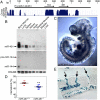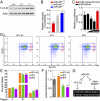Defective erythroid differentiation in miR-451 mutant mice mediated by 14-3-3zeta
- PMID: 20679397
- PMCID: PMC2912559
- DOI: 10.1101/gad.1942810
Defective erythroid differentiation in miR-451 mutant mice mediated by 14-3-3zeta
Abstract
Erythrocyte formation occurs throughout life in response to cytokine signaling. We show that microRNA-451 (miR-451) regulates erythropoiesis in vivo. Mice lacking miR-451 display a reduction in hematrocrit, an erythroid differentiation defect, and ineffective erythropoiesis in response to oxidative stress. 14-3-3zeta, an intracellular regulator of cytokine signaling that is repressed by miR-451, is up-regulated in miR-451(-/-) erythroblasts, and inhibition of 14-3-3zeta rescues their differentiation defect. These findings reveal an essential role of 14-3-3zeta as a mediator of the proerythroid differentiation actions of miR-451, and highlight the therapeutic potential of miR-451 inhibitors.
Figures





Similar articles
-
miR-451 protects against erythroid oxidant stress by repressing 14-3-3zeta.Genes Dev. 2010 Aug 1;24(15):1620-33. doi: 10.1101/gad.1942110. Genes Dev. 2010. PMID: 20679398 Free PMC article.
-
The miR-144/451 locus is required for erythroid homeostasis.J Exp Med. 2010 Jul 5;207(7):1351-8. doi: 10.1084/jem.20100458. Epub 2010 May 31. J Exp Med. 2010. PMID: 20513743 Free PMC article.
-
The regulatory roles of microRNA-146b-5p and its target platelet-derived growth factor receptor α (PDGFRA) in erythropoiesis and megakaryocytopoiesis.J Biol Chem. 2014 Aug 15;289(33):22600-22613. doi: 10.1074/jbc.M114.547380. Epub 2014 Jun 30. J Biol Chem. 2014. PMID: 24982425 Free PMC article.
-
KLF1 directly coordinates almost all aspects of terminal erythroid differentiation.IUBMB Life. 2010 Dec;62(12):886-90. doi: 10.1002/iub.404. IUBMB Life. 2010. PMID: 21190291 Review.
-
Regulation of GATA1 levels in erythropoiesis.IUBMB Life. 2020 Jan;72(1):89-105. doi: 10.1002/iub.2192. Epub 2019 Nov 25. IUBMB Life. 2020. PMID: 31769197 Review.
Cited by
-
MiR-451 inhibits proliferation of esophageal carcinoma cell line EC9706 by targeting CDKN2D and MAP3K1.World J Gastroenterol. 2015 May 21;21(19):5867-76. doi: 10.3748/wjg.v21.i19.5867. World J Gastroenterol. 2015. PMID: 26019450 Free PMC article.
-
MicroRNA regulation of T-cell differentiation and function.Immunol Rev. 2013 May;253(1):65-81. doi: 10.1111/imr.12061. Immunol Rev. 2013. PMID: 23550639 Free PMC article. Review.
-
MicroRNA-451a inhibits gemcitabine-refractory biliary tract cancer progression by suppressing the MIF-mediated PI3K/AKT pathway.Mol Ther Nucleic Acids. 2023 Oct 28;34:102054. doi: 10.1016/j.omtn.2023.102054. eCollection 2023 Dec 12. Mol Ther Nucleic Acids. 2023. PMID: 38111913 Free PMC article.
-
Deletion of miR-451 curbs JAK2(V617F)-induced erythrocytosis in polycythemia vera by oxidative stress-mediated erythroblast apoptosis and hemolysis.Haematologica. 2020 Apr;105(4):e153-e156. doi: 10.3324/haematol.2018.210799. Epub 2019 Aug 8. Haematologica. 2020. PMID: 31399524 Free PMC article. No abstract available.
-
Altered expression of 14-3-3ζ protein in spinal cords of rat fetuses with spina bifida aperta.PLoS One. 2013 Aug 6;8(8):e70457. doi: 10.1371/journal.pone.0070457. Print 2013. PLoS One. 2013. PMID: 23936434 Free PMC article.
References
-
- Aitken A 2006. 14-3-3 proteins: A historic overview. Semin Cancer Biol 16: 162–172 - PubMed
-
- Ambros V 2001. MicroRNAs: Tiny regulators with great potential. Cell 107: 823–826 - PubMed
-
- Barry EF, Felquer FA, Powell JA, Biggs L, Stomski FC, Urbani A, Ramshaw H, Hoffmann P, Wilce MC, Grimbaldeston MA, et al. 2009. 14-3-3:Shc scaffolds integrate phosphoserine and phosphotyrosine signaling to regulate phosphatidylinositol 3-kinase activation and cell survival. J Biol Chem 284: 12080–12090 - PMC - PubMed
-
- Bruchova-Votavova H, Yoon D, Prchal JT 2010. miR-451 enhances erythroid differentiation in K562 cells. Leuk Lymphoma 51: 686–693 - PubMed
Publication types
MeSH terms
Substances
Grants and funding
LinkOut - more resources
Full Text Sources
Other Literature Sources
Molecular Biology Databases
